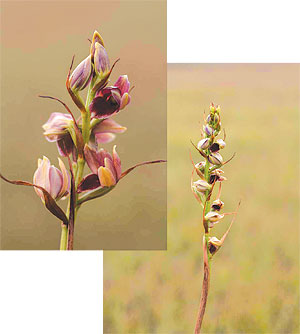
Nature enthusiasts who visit the District’s Potts Preserve from late July through October should keep an eye out for a rare orchid first discovered on this Citrus County land.
Joel DeAngelis, a District senior land management specialist, discovered the orchid in October growing in the open grassland of Potts Preserve. DeAngelis brought Paul M. Brown, a research associate with the University of Florida Herbarium, to the site in November.
“When Paul saw it, he had a strong inclination that the plant may be a new species,” said DeAngelis. “After about two months of observing the specimens against the reference species, Pteroglossaspis ecristata, and conferring with other experts, Paul told me he intended to introduce the orchid as a new species — Pteroglossaspis pottsii.”
The genus Pteroglossaspis is one of several orchids found in Africa, the southeastern United States and Central and South America. While most of the other species in the genus have large showy flowers, the species in the southeastern states generally have smaller yellow-green flowers with black markings. Pteroglossaspis pottsi is a shorter, denser plant with smaller flowers and it blooms later than Pteroglossaspis ecristata.
“In April, Paul released the species description as an insert to his book Wild Orchids of Florida, Updated and Expanded Edition at the Florida Native Plant Society’s annual conference,” said DeAngelis. “We also gave a presentation at the conference to discuss the plant in more detail and expand on the importance of sound land management practices to its long-term survival.”
The new species is named after Potts Preserve, which was named after a District employee. Michael T. Potts passed away on the property while conducting preacquisition survey work.
The orchid colony, which is estimated to include hundreds of plants, grows in open pasture that was cleared in the mid-1970s by cattle farmers. The hydrology of the area was also impacted by draining and ditching wetlands to increase the cattle’s grazing area. Grazing took place on the land until the District purchased the property in the early 1990s.
Since the District purchased the land, sections of the ditches were backfilled using the spoil to restore the wetland’s hydrologic cycles. The District has also allowed the pasture to undergo natural succession and regularly conducts prescribed burns on the pasture to enhance the recovery of native species.
While pastures have replaced many natural areas throughout the New Orchid Species Discovered on District Land state, they still function as an important component of the environment. Prescribed fire is necessary to keep these areas open and connected to surroundings lands. In some cases more active restoration methods are employed, which are directed at reintroducing the plant species that formerly occupied the site.
In the case of Pteroglossaspis pottsii, it is likely that the orchid colony has been growing in the area for quite some time. However, to survive, the plant had to adapt to endure the impacts of conversion to pasture and long-term cattle grazing. Frequent burning in the past to maintain the pasture may have been the primary factor allowing Pteroglossaspis pottsii to persist on the site.
“With increasing losses of habitat to development, management of Florida’s conservation lands has become more focused on maximizing habitat quality,” said DeAngelis. “District land management practices emphasize growingseason prescribed burns to replicate natural processes and the restoration of upland communities for endangered species such as the Florida scrub-jay.”
“It wouldn’t be a stretch to say there may be other species on District lands that have yet to be discovered,” said Kevin Love, District land manager. “Our conservation lands are home to a wide variety of plants, animals and reptiles. It’s important that we manage the land well.”
And while orchid fans may want to take one of these rare beauties home, survival is slim once wild orchids are taken from their native habitats.
“Wild orchids have specific associations with fungi in the soil and most do not survive when they are removed from their native environment,” said DeAngelis. “To protect these species, the District prohibits the removal of any plants or animals from District lands. Removing individual plants can endanger an entire population.”
To learn more about the variety of plants, animals, insects and reptiles that live in our state, visit the Florida Natural Areas Inventory web site at FNAI.org/.
